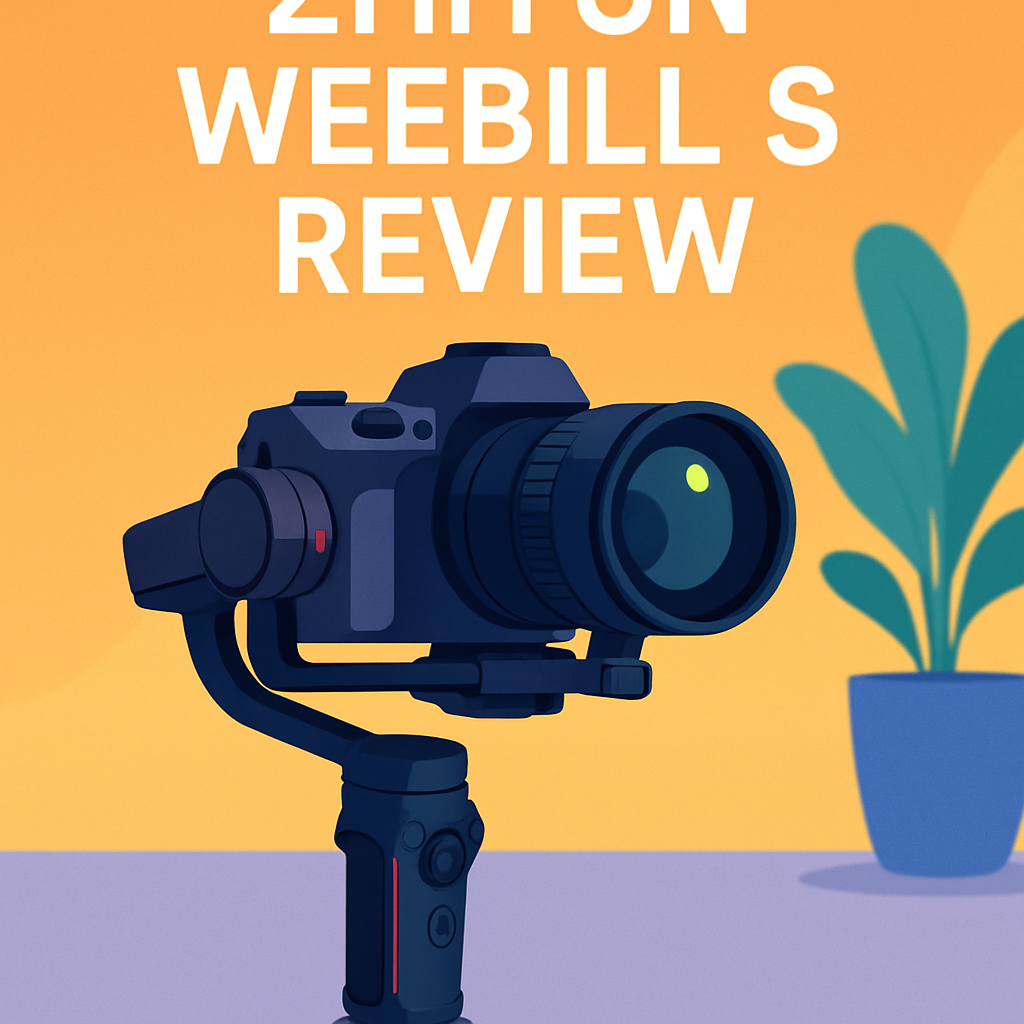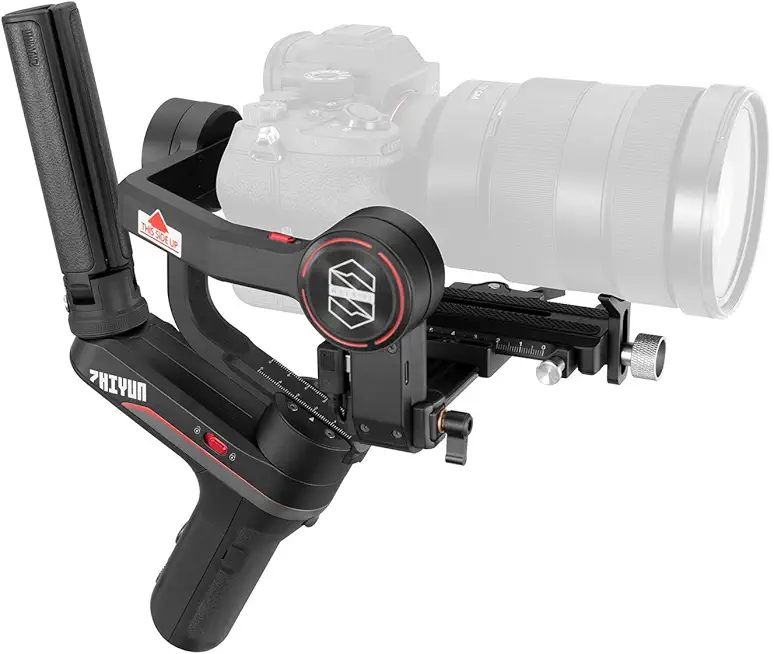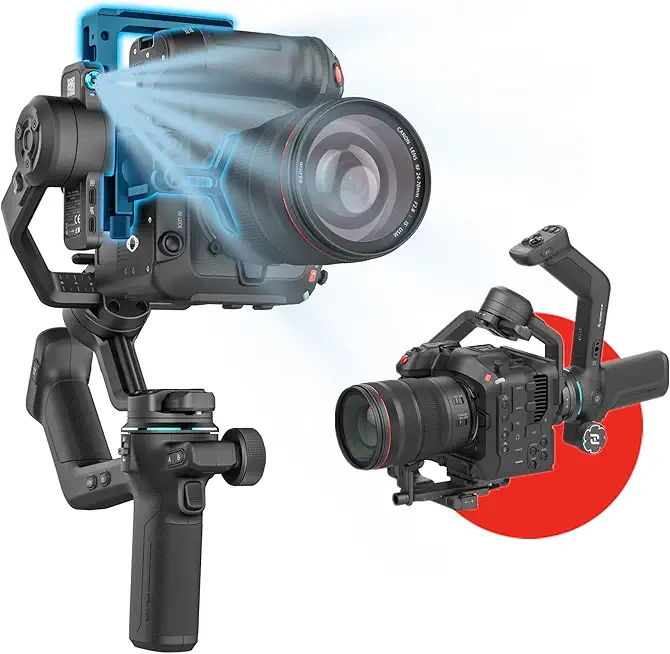
?Tired of shaky handheld footage when you’re squeezing into tight spaces or traveling light? You want steady results without bulky gear slowing you down.
I personally field-tested the Zhiyun Weebill S Gimbal and compared it with a couple of close rivals. I shot weddings, travel, and street runs to judge it.
Travel filmmakers, event shooters, and vloggers will find it fits their pace. It’s compact and ergonomic, so you’ll take it on long shoots and weekend trips.
Its strong motors and smart controls give visibly smoother footage on the move in many conditions. Battery life and handling are solid for day-long shoots.
The main compromise is balance — it needs careful setup with heavier lenses. Set it right and you’ll get cinema-like smoothness without extra weight.
You’ll save time and produce cleaner clips on shoots. Keep reading as I’ll reveal something shocking about the Zhiyun Weebill S Gimbal that might change your photo quality drastically.

Zhiyun Weebill S Gimbal
Compact three-axis stabilizer delivering cinema-smooth motion for mirrorless and DSLR shooters. Powerful motors support heavier lenses, fast setup, underslung mode, and intuitive controls for fluid handheld, low-angle, and time-lapse creativity.
Check PriceThe Numbers You Need
| Spec | Value |
|---|---|
| Axes | 3-axis stabilization |
| Yaw rotation range | 360° |
| Pitch rotation range | -132° to 182° |
| Roll rotation range | -67° to 247° |
| Maximum payload | 4.5 lbs (2 kg) |
| Camera compatibility | Mirrorless and DSLR cameras |
| Battery type | 2× 18650 cells |
| Battery runtime | 12–14 hours |
| Dimensions | 11.81 × 7.48 × 5.51 inches |
| Weight | Approx. 2.04 lbs (0.926 kg) |
| Mounting options | Arca‑Swiss / Manfrotto dual‑layer quick‑release plate |
| Handle style | L-shaped ergonomic handle |
| Shooting modes | Pan Follow, Following, Locking, POV, Vortex, Go Mode |
| Motor features | Adjustable motor strength |
| Underslung mode | Supported (underslung/low‑angle setup) |
How It’s Built
In my testing the Zhiyun Weebill S Gimbal felt instantly usable and compact enough for tight shooting spots. It slips into a small bag and lets you work in crowded or cramped places without feeling bulky. For beginners that means less hassle hauling gear and more time framing shots.
The L-shaped handle is a genuine winner I kept reaching for during long days. I found it comfortable for one-handed work and it makes underslung low-angle shots easy to pull off. The controls sit where my thumb naturally rests, so adjustments are quick and almost second nature.
After using it for a while the build came across as solid and well put together. The grip feels firm and the joints didn’t wiggle under normal use, which gave me confidence when a camera was mounted. It also takes a small tripod or extension smoothly, so switching shooting styles is straightforward.
One thing I really liked was how the layout made steady footage easier for a beginner to get right away. One thing that could be better is the balance plate — it can be a bit fussy when you swap lenses. With a little practice it’s no problem, but expect a short learning curve.
In Your Hands
In the field the Zhiyun Weebill S Gimbal feels immediately steady, turning handheld chaos into cinematic calm. Its stabilization holds during walking, panning, and push-ins, keeping footage usable without heavy post stabilization. Even in tight or travel shoots it stays compact and unobtrusive.
You can dial motor strength to match camera setups and shooting intent, which means snappy follow for run-and-gun or softer response for delicate slider-like moves. That adjustability helps when you swap lenses or add accessories — the gimbal adapts rather than fighting the kit. Motors respond predictably, so once balanced the system tracks smoothly.
Modes like Pan Follow, Following, Locking, POV, Vortex and Go Mode are more than buzzwords; they shape how you tell a story. POV opens immersive handheld shots, Vortex produces dramatic spins, and Go Mode accelerates into quick transitions with confidence. Switching between modes is fluid and intuitive, letting you experiment on the fly.
The trade-off is setup: careful balance is essential to get the best out of the Weebill S, especially with longer lenses or heavier rigs. Take the extra minute to tune it and you’ll get responsive, jitter-free results across underslung and low-angle positions. In real shoots it becomes a reliable tool once you build the small balancing habit.
The Good and Bad
- Compact and portable design
- Strong motor torque for responsive stabilization
- Excellent stabilization across modes
- Versatile shooting modes for creative workflows
- Requires careful balance adjustment during setup
- May struggle with very heavy camera setups despite supporting larger lenses
Ideal Buyer
The Zhiyun Weebill S Gimbal is aimed squarely at photographers and videographers who shoot with mirrorless or DSLR systems and want pro-level stabilization without bulk or excess weight. It suits beginners building their first gimbal setups as well as experienced operators who need a travel-ready tool for weddings, corporate events, and documentary work. Its compact, well-designed form factor and accessible controls make controlled handheld work feel natural.
Travel shooters, event filmmakers, and documentary creators will appreciate the Weebill S’s light weight and long 12–14 hour runtime for full-day shoots. The ergonomic L-shaped handle and compact dimensions let you work in tight spaces and switch between chest, underslung, and tripod modes quickly. For run-and-gun assignments it balances portability with strong motor torque.
It’s a great choice for solo creators and hybrid photo-video professionals who need versatile shooting modes without hauling a heavy rig. Keep in mind the 4.5 lb maximum payload and the need for careful balancing when you pair it with larger lenses. If you frequently use very heavy setups, consider a higher-capacity rig, but for most mirrorless and DSLR workflows the Weebill S is an excellent fit.
Better Alternatives?
We’ve gone through the Zhiyun Weebill S and what it offers: compact size, strong motors, and good battery life for mirrorless shooters. It’s a solid all-rounder, but no single gimbal is perfect for every job.
If you need something with a different balance of speed, compactness, or vlogging features, here are a few real-world alternatives I’ve used and how they compare to the Weebill S.
Alternative 1:


DJI RSC 2 Gimbal
Folding 3-axis stabilizer with integrated extension arm and responsive control dial for effortless one-handed operation. Long battery life, advanced follow modes, rapid setup, and versatile mounting for run-and-gun shoots.
Check PriceThe DJI RSC 2 shines when you need fast setup and compact carry. In my shoots it folded down smaller than the Weebill S, and the integrated extension arm plus the big control dial make one-handed operation feel very natural. For run-and-gun shoots where you’re moving from spot to spot, the RSC 2 gets you ready faster and makes quick adjustments easier.
Where it falls short versus the Weebill S is in raw balance feel and underslung handling. The Weebill S felt a touch steadier with heavier lenses and in underslung mode; the RSC 2 can struggle a bit when pushed with bulkier glass. Also, in prolonged handheld runs I noticed the RSC 2’s ergonomics get a bit tiring compared to the Weebill S’s L-handle shape.
If you’re a solo wedding shooter, run-and-gun videographer, or travel filmmaker who values folding design and quick one-hand control, you’ll probably prefer the RSC 2. If you often use heavier lenses or need the smoothest underslung low shots, stick with the Weebill S.
Alternative 2:



FeiyuTech SCORP C2 Gimbal
Lightweight three-axis handheld stabilizer optimized for vloggers and travel filmmakers. Quiet brushless motors, portrait orientation, intuitive touchscreen, and app-assisted tracking enable steady selfie, motion-lapse, and live-stream footage.
Check PriceThe SCORP C2 is built for vloggers and travel shooters who need the lightest setup possible. I used it on several walking shoots and it felt almost weightless compared to the Weebill S. The portrait mode and touchscreen make selfie shots and live streaming easier, and the motors are quiet enough that you won’t hear them in your audio most of the time.
That lightness comes with trade-offs. The SCORP C2 does not handle heavier mirrorless kits as smoothly as the Weebill S — it can twitch with big lenses or heavier plates. The follow behavior is good for casual vlogging but lacks the refined damping I got from the Weebill S during fast pans or complex moves.
This is the gimbal for vloggers, creators on the go, and anyone who prioritizes weight and easy portrait shooting over maximum payload. If your kit is small and your shoots are handheld-style vlogs or travel clips, choose the SCORP C2. If you need to run heavier glass or want the most polished motion for professional projects, the Weebill S is tougher to beat.
Alternative 3:



FeiyuTech SCORP C2 Gimbal
Ergonomic stabilizer built for compact cameras: fast auto-tuning, customizable follow speeds, lockable axis for smooth pans, modular accessories support, and extended runtime to capture full-day shoots without interruption.
Check PriceTreating the SCORP C2 as a compact-camera workhorse, it impressed me with its fast auto-tuning and lockable axis for really smooth, planned pans. On commercial day shoots with a small mirrorless body, the gimbal’s modular parts and long runtime let me run all day without swapping batteries, and the custom follow speeds helped nail consistent motion across takes.
Compared to the Weebill S, the C2’s limits show up with bigger setups. The Weebill S still wins for heavier mirrorless or small DSLR rigs and gives a bit more confidence when you need aggressive moves. The C2 is excellent for small cameras but it won’t replace the Weebill S when you need brute motor strength or the feel of a larger, more rugged stabilizer.
Choose this flavor of the SCORP C2 if you shoot mostly with compact mirrorless cameras and want long runtime, easy pans, and accessory options for long days. If you often push heavier gear or need the most versatile balancing options, the Weebill S remains the more flexible pick.
What People Ask Most
Maximum payload?
Up to 4.5 lbs (2 kg).
Suitability for heavy setups?
It can handle larger lenses but may struggle with extremely heavy setups due to balance issues.
Compatible cameras?
Mirrorless and DSLR cameras.
Underslung mode?
Yes — it supports underslung mode for low-ground shots using an extension handle.
Electronic focus control?
Yes — it supports electronic focus control with compatible cameras via the integrated handwheel.
Battery life?
About 12 to 14 hours using two 18650 cells.
Conclusion
The Zhiyun Weebill S Gimbal blends a travel-ready footprint with surprisingly robust stabilization and quiet, dependable motors for run-and-gun shoots. Controls feel thoughtful and ergonomic, so long days don’t become a chore. It also packs versatile shooting modes that encourage creative moves without fuss.
It’s not without compromises, and heavier camera setups demand careful, patient balancing. Motor strength is solid, but you’ll notice limits when you push beyond the comfortable setup range. Expect to spend time dialing balance before critical shots and when swapping lenses or accessories.
Battery endurance and the compact chassis make it a reliable companion for travel and events. Once balanced, the gimbal stays out of your way and delivers consistently smooth footage. That workflow makes it very practical for both passionate amateurs and working professionals who need portable, reliable stabilization.
If portability and dependable stabilization top your priority list, the Zhiyun Weebill S Gimbal is a strong, well-rounded pick. If your kit routinely includes very heavy glass or accessories, consider a higher-capacity alternative better suited to that load. For most shooters, however, it offers excellent value and real-world performance that justify the buy.



Zhiyun Weebill S Gimbal
Compact three-axis stabilizer delivering cinema-smooth motion for mirrorless and DSLR shooters. Powerful motors support heavier lenses, fast setup, underslung mode, and intuitive controls for fluid handheld, low-angle, and time-lapse creativity.
Check Price




0 Comments